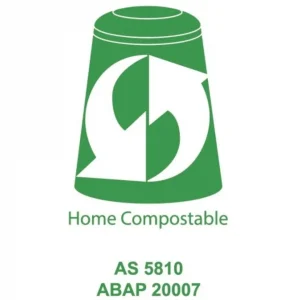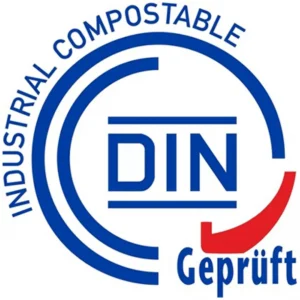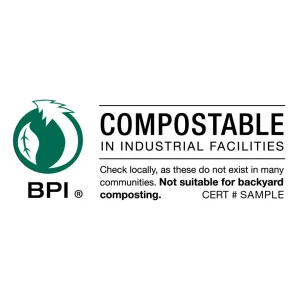The now eco friendly terms biodegradable and compostable get thrown around all too often these days. I frequently used them interchangeably and decided to investigate more closely what each means regarding our plastic waste and it’s environmental impact.
Read on to learn more about Compostable vs Biodegradable plastics.
Biodegradable
Biodegradable plastics: The term biodegradable means a product or material must break down and decompose. Unlike compostable, there is no time limit on this; it may take years for biodegradable plastic materials to fully degrade, depending on the environment and conditions. Also, it doesn’t necessarily imply that the biodegradable plastics can be converted into good-quality compost.
A positive of biodegradable material is when disposed of in a Landfill site, Biodegradable products have the benefit of improving landfill-gas recovery and creating a volume reduction of the waste thanks to biodegradation.
Several standards cover biodegradable material testing and certification; honestly, it could be more straightforward. To help avoid confusion, it is best to treat any items labeled as biodegradable as general waste.
Industrially Compostable
Industrially Compostable: Also known as commercial composting, this means a product/material must break down and compost via biological processes into natural elements in less than 6 months in a commercially compostable environment, leaving no harmful contaminants.
Again there are numerous standards, but generally anything labeled as compostable is best treated as industrially compostable to ensure you correctly dispose of these compostable items.
Please do not put these into your home composting bin, as the conditions and temperatures are not sufficient to compost them.
Home Compostable
Home Compostable: This means compostable plastic or other compostable materials must break down and decompose in less than 12 months in a home composting environment, leaving no harmful contaminants.
Various labels are used for home compostable products, but all share the text “home compostable.”
These items are the only ones that should be placed into your home compost bin and meet the appropriate standards for decomposing into healthy compost. For more information on home composting check out our in-depth article.
Common Certification and Labelling
There are numerous certification bodies depending on your location. Below I have listed the common certifying authorities and the labelling they use.
Home Compostable Approval

European Labelling
Standard: EN13432/EN 14995
Certified for Home Composting

European Labelling
Standard: AS 5810
Certified for Home Composting

Australasian Labelling
Standard: AS 5810
Certified for Home Composting
Industrial Compostable Approval

European Labelling
Standard: EN13432/EN 14995
Certified for Home Composting

European Labelling
Standard: EN 13432/EN 14995
Certified for Home Composting

North American Labelling
Standard: ASTM D6400
Certified for Home Composting

Australasian Labelling
Standard: AS 4736
Certified for Home Composting
Common Standards
Several organizations define standards for biodegradable/compostable plastics, whether the International Organization for Standardization, the American Society for Testing and Materials, or the European Union. Some standards/specifications are listed below.
International
ISO 17088:2021: Plastics — Organic recycling — Specifications for compostable plastics
ISO 16929:2021: Plastics — Determination of the degree of disintegration of plastic materials under defined composting conditions in a pilot-scale test.
North America
ASTM D5526: Standard Test Method for Determining Anaerobic Biodegradation of Plastic Materials Under Accelerated Landfill Conditions
ASTM D6400: Standard Specification for Labelling of Plastics Designed to be Aerobically Composted in Municipal or Industrial Facilities
European Union
EN 13432 standard: Requirements for packaging recoverable through composting and biodegradation
EN 14995 Plastics – Evaluation of compostability
Australasian Region
Set by the Australian Government.
AS 4736-2006: Industrial Compostability
AS 5810-2010: Home Compostable
Certifying Authorities
Depending on the area of the world there are many authorities than certify plastics for biodegradability and suitability for composting. Below are the primary ones I found:
USA:
The Biodegradable Products Institute (BPI) certifies compostable products and packaging in North America.
Currently, they do not certify products for home composting. All products labeled as Compostable must be disposed of in industrial composting facilities.
EU
Din Certco also known as TUV Rheinland certifies products for industrial composting only.
TÜV AUSTRIA certifies products for industrial and home composting as well as several other qualities such as biobased and biodegradable.
Australasian Region
The Australasian Bioplastics Association test and certify biodegradable plastics in the Australasian Region.
Compostable vs Biodegradable Wrap Up:
Depending on the country you call home, the standards and certification labelling in place for biodegradable and compostable material vary massively and should be checked locally to ensure you fully understand how to dispose of your waste.
As a simple suggestion, I would like to advise the following:
- Home compost: Unless clearly labeled by a recognized certifying authority as Home Compostable, do not place any plastics/packaging in your compost as it is not suitable for the home composting process and may impact soil health.
- Commercial Compost: When an item is labelled Compostable by a recognized authority, treat as commercially compostable and ensure it is correctly disposed of at an industrial composting facility. If unsure, place these items in general waste bins.
- Biodegradable Materials Plastics marked as biodegradable are unsuitable for home composting or industrial composting and should be disposed of with general waste.
- General Waste: Always place any waste in your general rubbish bin if you have any doubts.
Assuming the worst-case scenario for a product’s ability to degrade will avoid the contamination of the recycling and compost environment with plastics and toxic waste not designed for them.
Avoiding waste is a great way to reduce environmental damage. Although the goal of zero waste is ideal, it is only sometimes achievable.
Using compostable and biodegradable products is an easy improvement when zero waste is impossible. Small changes like these can have a significant environmental impact creating a cleaner home for all. So let’s do our part and make a difference for our planet by correctly disposing of biodegradable and compostable products!